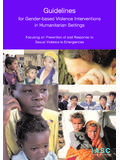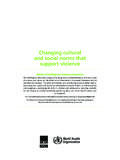Transcription of COMMUNITYMOBILIZATION - PreventConnect eLearning
1 COMMUNITYMOBILIZATIONand Primary PreventionA national project ofLearning2 COMMUNITYMOBILIZATIONand Primary PreventionA national project ofLearningIntroduction to This CourseEducational Objectives Understand community mobilization as it relates to the primary prevention of sexual assault and domestic violence. Learn about examples of success-ful sexual assault and domestic violence community mobilization purpose of this course is to support and motivate you as you apply community mobilization theory and techniques in your sexual assault and domestic violence prevention work. We assume that you are familiar with the basic theory and practice of community mobilization , along with general concepts of primary prevention. We recommend that you review the documents available in the Prevention Overview to prepare you to get the most from this course. The goal of this course is to support you as you incorporate community mobilization into your prevention practice through these educational and skill objectives:Skill Objectives Be able to incorporate community mobilization principles into general social ecological theory.
2 Develop locally specific strategies that hold promise for prevention, based on local demographics, organizational goals, and community Primary PreventionA national project ofLearningIntroduction to community MobilizationWhat it is and what it isn tCommunity mobilization is based on the simple premise that human beings are by nature social creatures whose behaviors, attitudes and beliefs are profoundly affected by the norms of the communities in which they live. It is the process of engaging communities to change the norms within their own communities. By its very nature it tends to be a primary level intervention. Its goal is to engage the community itself in activities that can prevent incidents of sexual and domestic violence. Keep in mind: Its purpose is not to educate communities, although communities will learn throughout the Primary PreventionA national project ofLearning Its purpose is not to provide services to communities, although communities may develop strategies that include providing support to survivors.
3 The purpose of community mobilization is to empower communities to recognize and change the existing norms relating to sexual assault and domestic mobilization is a systemic effort that engages a community : to define the issue of sexual assault and/or domestic violence; to recruit recruiting stakeholders, champions, and leaders to initiate and/or sustain change efforts; to develop a plan to prevent the violence as it occurs specifically in their community ; and to implement their Primary PreventionA national project ofLearningAs professionals, our role is facilitating this process. For many people working in sexual and domestic violence programs, the most difficult task in incorporating community mobilization into prevention work is adopting the mentor and facilitator role. We have a tendency to do the work ourselves, rather than engage the community . Making this shift can be a challenge. A community mobilization strategy requires a significant investment in time and resources if you are to serve as an effective mentor and facilitator.
4 It is most effective in communities that display a readiness to address the issues of sexual assault and domestic violence. Before engaging in an initiative, assess your resources and be aware of the possible benefits, challenges and common mistakes. Also take stock of your own comfort level with the role of facilitator and mentor and get training and mentoring if you feel it s Primary PreventionA national project ofLearningBenefits of community mobilization It naturally works toward primary prevention. It is by definition community specific. It encourages community buy-in. It is a facilitative communities have both community and cultural norms. Culture is the way of life of a particular society or group of people, including patterns of thought, beliefs, behavior, customs, traditions, rituals, dress, and language, as well as art, music, and literature. community mobilization encourages stakeholders to develop and implement strategies that reflect the culture of the given community .
5 When this happens, community mobilization initiatives become powerful tools in developing strategies that are culturally competent, relevant and compelling for historically marginalized communities. 7 COMMUNITYMOBILIZATIONand Primary PreventionA national project ofLearningMany historically marginalized communities experience a sense of disconnection from mainstream institutions. There has been an expectation that universal strategies are enough, the one size fits all concept. As a field, we have not invested enough resources in the development and implementation of strategies that address the reality of the intersection between oppression of all types and its violence against women work. With community mobilization as a framework, communities can begin to understand oppression as part of the analysis of sexual and domestic violence and from there develop strategies appropriate within a specific community . community mobilization can also leverage the rich history of culturally-specific strengths and Primary PreventionA national project ofLearningChallenges of community mobilization It requires significant initial investment of resources and relationship building.
6 Because the strategy is process oriented, it is difficult to implement effectively within highly prescriptive environments. community mobilization is a mix of structure and the unknown, making it a challenge to manage. While the aim is a standardized process, by definition the outcomes, outputs and activities will vary by community . It is a facilitative process and not a directive Primary PreventionA national project ofLearning Steps to Take - How to get started1. Establish a relationship with a community 2. Identify and recruit stakeholders 3. Gather stakeholders together into a mobilization Team 4. Engage your mobilization Team in developing a plan: a. an asset mapping and/or community assessment processb. developing an analysis of sexual and/or domestic violence c. developing a community mobilization pland. developing an evaluation plan 10 COMMUNITYMOBILIZATIONand Primary PreventionA national project ofLearning5. Engage your mobilization Team in implimenting the plan: a.
7 Implementing a community mobilization planb. cultivating/maintaining assetsc. evaluating progressd. assuming leadership roles in the mobilization process e. developing a sustainability plan 6. Facilitate transfer of leadership of initiative to mobilization TeamThere are many specific community develop frameworks that can be implemented. Adaptations of frameworks by by the Asset Based community Development Institute and William Lofquist have been used in violence against women community mobilization work, but there are many to choose from. Some frameworks lend themselves better to geographically-based communities, while others work better in communities bound together by other shared traits. What is most important is that you choose a framework that resonates for you and that you are prepared to engage in authentic power Primary PreventionA national project ofLearningCommunity mobilization is all about relationships. To provide an initiative with the best chance for success you must have an existing positive relationship with a community that has a medium to high degree of readiness to address the sexual and/or domestic violence happening in its Mistakes Most, if not all, community mobilization efforts will encounter prescribed structures that place limitations on some of the strategies that the group can realistically implement.
8 Not understanding or acknowledging prescriptive parameters can be a costly mistake. Not trusting the wisdom of the group and/or allowing them to self-correct. Not identifying the correct stakeholders and/or being willing to add new stakeholders when they are identified. Misjudging community readiness. 12 COMMUNITYMOBILIZATIONand Primary PreventionA national project ofLearning Not allowing enough time; community mobilizing is a time-intensive strategy. Not being committed to the entire process, in which the means are as important as the mobilization can be a wonderful strategy, providing you have a good knowledge of the dynamics of sexual and/or domestic violence, facilitation skills, community mobilization theory and a true affinity for the communities you are attempting to who promote positive change most effectively are not those who provide a new set of answers, but those who allow a new set of questions. 13 COMMUNITYMOBILIZATIONand Primary PreventionA national project ofLearningConnecting community mobilization to the Social-Ecological Model of PreventionCommunity mobilization has the potential to impact all levels of the social-ecological model, even as the community level will be the designated or primary focus.
9 As stakeholders engage in the mobilization efforts, the individual and relationship levels are impacted. Successful projects will change community norms regarding sexual assault and domestic violence. community norms and societal norms regarding violence against women are deeply intertwined; as community norms shift the larger societal norms will also Primary PreventionA national project ofLearningSome Examples of use of community mobilization in the field In the next section, we will provide examples of community mobilization initiatives, organized within the various levels of the social ecological model. 15 COMMUNITYMOBILIZATIONand Primary PreventionA national project ofLearningIndividual Washington Middle School Prevention Project was a school based initiative with a goal to create an urban middle school climate in which sexual harassment and sexual assault was unacceptable. The program was designed to change the community (school) norms regarding sexual harassment.
10 A group of stakeholders that included students, parents, administrators, school counselors, teachers, prevention project staff, and intervention staff from other social service agencies housed at the school developed and implemented the project plan. They created three strategies focused on each major constituency within the school: students, school personnel and parents. Each strategy was comprised of several linked activities ranging from peer based training to policy review. The individual level was not the designated focus. However, the group understood that individual stakeholders would increase their knowledge of sexual violence and also gain skills in the prevention of sexual violence through the implementation of the plan. Students learned to identify sexual harassment, to identify media influences, to challenge rigid gender expectations as well as some techniques for bystander intervention. School personnel learned to identify sexual harassment, basic information about sexual assault/sexual harassment, knowledge of their title IX requirements and to implement sexual harassment policies more equitably across programs.



